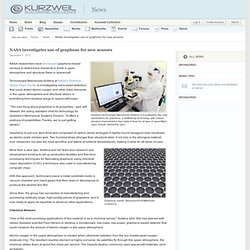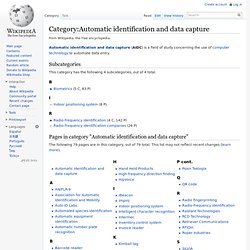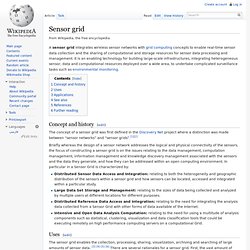

Marvell Technology Group Ltd. Marvell Technology Group. Marvell Technology Group, Limited, is a producer of storage, communications and consumer semiconductor products.

The company was founded in 1995 and has approximately 7,000 employees.[1] Marvell's U.S. operating headquarters is located in Santa Clara, California, and the company operates design centers in places including Canada, Europe, Israel, India, Singapore and China.[2] Marvell is a fabless semiconductor company and ships more than one billion integrated circuits (known as "chips") per year.[1] Its market segments include high volume storage, mobile and wireless, networking, consumer, and digital entertainment.[3] History[edit] The company is officially headquartered in Hamilton, Bermuda.[5] The US operations known as Marvell Semiconductor, Incorporated, are located in Silicon Valley, California.[7] Acquisitions[edit] Through the years, Marvell acquired smaller companies to enter new markets.
Marvell's operating headquarters in Santa Clara. Solutions - Plug Computers. Whether the need is remote access to data on a home network or to turn an entire classroom into a highly interactive learning environment, the solution is simple, convenient, and inexpensive.

With a small form factor server called a plug computer, network connectivity is right at a wall socket. Simply insert the plug computer into an electrical outlet and add an external hard drive or a USB flash drive through a USB port (depending on the deployment, a router may also need to be connected) — just like that, you have a network attached storage device. Powered by Marvell embedded processors, a plug computer is packed with enough processing power and network connectivity for managing and serving up digital media files. It also draws less than one tenth of the power consumed by its PC counterparts enabling always-on, always-connected, and environmentally friendly computing. Applications for a plug computer include: Media Server Home Automation Remote Access A micro cloud for the classroom. TinyOS Home Page. NASA investigates use of graphene for new sensors.
Goddard technologist Mahmooda Sultana is investigating two new applications for graphene, a trailblazing technology with unique physical characteristics that make if ideal for all type of spaceflight uses.

(Credit: NASA/Pat Izzo) NASA researchers have developed graphene-based sensors to detect trace elements in Earth’s upper atmosphere and structural flaws in spacecraft. Technologist Mahmooda Sultana at NASA’s Goddard Space Flight Center is investigating nano-sized detectors that could detect atomic oxygen and other trace elements in the upper atmosphere and structural strains in everything from airplane wings to spacecraft buses.
“The cool thing about graphene is its properties,” said Jeff Stewart, the acting assistant chief for technology for Goddard’s Mechanical Systems Division. A low-cost, implantable electronic biosensor. Field effect transistor protein biosensor schematic.

A sensing channel connects the source (S) and drain (D) with a reference electrode (RE). When a target analyte (protein) binds to the receptor, it induces charges in the substrate, causing a change in the current flow between the source and drain (a protein detection). (Credit: Ohio State University) Ohio State University engineers are developing low-cost electronic devices that work in direct contact with living tissue inside the body. The initial objective is to develop an in vivo biosensor to detect the presence of proteins that mark the first signs of organ rejection in the body. Doctors would insert a needle into the patient’s body near the site of the implanted organ.
SCiO - Consumer Physics. Fear of Repression Spurs Scholars and Activists to Build Alternate Internets - Technology. By Jeffrey R.

Young Washington Computer networks proved their organizing power during the recent uprisings in the Middle East, in which Facebook pages amplified street protests that toppled dictators. But those same networks showed their weaknesses as well, such as when the Egyptian government walled off most of its citizens from the Internet in an attempt to silence protesters.
That has led scholars and activists increasingly to consider the Internet's wiring as a disputed political frontier.
Sensor. The Internet of Things. Sensors - The information centre for sensors and data systems. AZoSensors - The A to Z of Sensors and Sensing Technology. SENSORICA. Sensor web. The concept of the "sensor web" is a type of sensor network that is especially well suited for environmental monitoring.[1][2][3] The phrase the "sensor web" is also associated with a sensing system which heavily utilizes the World Wide Web.

OGC's Sensor Web Enablement (SWE) framework defines a suite of web service interfaces and communication protocols abstracting from the heterogeneity of sensor (network) communication.[4] Definition[edit] Characteristics of Delin's sensor web architecture[edit] Delin designed a sensor web as a web of interconnected pods. All pods in a sensor web are equivalent in hardware (there are no special "gateway" or "slave" pods). The term of mother pod refers to the pod that contains the master clock of the synchronous sensor web system. Each pod usually contains:[2] See also[edit] References[edit] ^ Jump up to: a b Delin, Kevin; Shannon Jackson (2000). Further reading[edit] External links[edit] Semantic Sensor Web. Millions of sensors around the globe currently collect avalanches of data about our environment.

The rapid development and deployment of sensor technology involves many different types of sensors, both remote and in situ, with such diverse capabilities as range, modality, and maneuverability. It is possible today to utilize networks with multiple sensors to detect and identify objects of interest up close or from a great distance. Category:Automatic identification and data capture. From Wikipedia, the free encyclopedia Automatic identification and data capture (AIDC) is a field of study concerning the use of computer technology to automate data entry.

Subcategories This category has the following 4 subcategories, out of 4 total. Sensor grid. A sensor grid integrates wireless sensor networks with grid computing concepts to enable real-time sensor data collection and the sharing of computational and storage resources for sensor data processing and management.

It is an enabling technology for building large-scale infrastructures, integrating heterogeneous sensor, data and computational resources deployed over a wide area, to undertake complicated surveillance tasks such as environmental monitoring. Commotion Wireless - Aperçu - Chambana.net Tech Projects. SheevaPlug. The SheevaPlug is a "plug computer" designed to allow standard computing features in as small a space as possible.

Commercial products[edit] The following commercial products are known to be based on the SheevaPlug platform: Hosting@home solution. FreedomBox Foundation. FreedomBox. FreedomBox is a community project to develop, design and promote[1] personal servers running free software for distributed social networking, email and audio/video communications.[2] The project was announced by Eben Moglen at the New York ISOC meeting on February 2, 2010.[3] On February 4, 2011, Moglen formed the FreedomBox Foundation to become the organizational headquarters of the project,[4] and on February 18, 2011, the foundation started a campaign to raise $60,000 in 30 days on the crowdfunding service, Kickstarter.[5] The goal was met on February 22,[6] and on March 19, 2011, the campaign ended after collecting $86,724 from 1,007 backers.[5] The project currently describes a FreedomBox as The developers aim to create and preserve personal privacy by providing a secure platform for building federated social networks.[7] This shall be done by creating a software stack that can run on plug computers that can easily be located in individual residences or offices.
Releases[edit] Eben Moglen Is Reshaping Internet With a Freedom Box. PlugComputer Community. Www.forum-plugcomputer.net. Plug computer. CloudPlug, a plug computer developed by CTERA Networks Seagate Dockstar, a plug computer similar to the SheevaPlug. H:D. The Past, Present, and Future of Data Storage. As we approach the end of 2011 and look forward to another year, we pause to reflect on the long history of data storage. Mankind's ability to create, process, store, and recall information is light years ahead of the days of cave paintings and engravings on stone tablets. Vast amounts of information can be stored on drives smaller than your thumb, and data centers are cropping up at an increasingly high rate. What does the future of data storage hold? Are we really that close to holographic drives? Is 2012 the year SSDs become mainstream? Phidgets Inc. - Unique and Easy to Use USB Interfaces.
Electronics. Engineering ToolBox. GlobalSpec - Engineering Search & Industrial Supplier Catalogs.